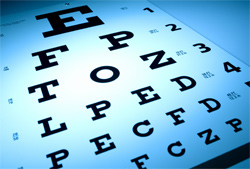Comprehensive Eye Care
Frequently asked questions about comprehensive eye care:
Why eye exams are important?Routine eye exams are absolutely essential in not only maintaining clear vision but to also protect the health of your eyes. Eye examinations give our specialists an opportunity to detect and inform you about eye disorders such as Glaucoma, cataracts, and diabetic retinopathy as well as report on general health conditions such as diabetes and high blood pressure. To allow proper treatment, early detection of eye conditions is critical. Who should get their eye examined?Eye examinations are an important part of health maintenance for everyone. Adults should have their eyes tested to keep their prescriptions current and to check for early signs of eye disease. Eye exams for children play an important role in ensuring normal vision development and allowing for academic achievements that can be hampered by vision problems. Vision is closely linked to the learning process. Children with undetected vision problems often will have trouble with their schoolwork. Many times, children will not complain of vision problems simply because they don't know what "normal" vision looks like. To make an appointment, call our office at , or request an appointment online. Why vision screenings are no substitute for Comprehensive Eye Exams?Eye exams that are performed by a school nurse or your employer are not the same as a comprehensive eye exam given by a certified optometrist. An optometrist will screen your vision thoroughly for eye and other diseases that can lead to vision loss. Treating these complications early is an essential reason to visit your eye doctor on a regular basis. An eye exam is a series of tests performed by an optometrist assessing one’s ability to focus on and recognize objects within a field of vision as well as other tests and examinations related to the eyes. What should you expect during a Comprehensive Eye Exam?
Preliminary testing may include evaluation of specific aspects of visual function and eye health such as depth perception, color vision, eye muscle movements, peripheral or side vision, and the way your pupils respond to light. External examination of the eye includes evaluation of the cornea, eyelids, conjunctiva and surrounding eye tissue using bright light and magnification. Visual acuity measurements evaluate how clearly each eye is seeing. As part of the testing, you are asked to read letters on distance and near reading charts. The results of visual acuity testing are written as a fraction such as 20/40. Assessment of accommodation, ocular motility and binocular vision determines how well the eyes focus, move and work together. In order to obtain a clear, single image of what is being viewed, the eyes must effectively change focus, move and work in unison. This testing will look for problems that keep your eyes from focusing effectively or make using both eyes together difficult. Evaluating the way your eyes work together and individually can tell us if the nerves and muscles controlling your eyes are working properly or require more investigation. Additional testing may be needed based on the results of the previous tests to confirm or rule out possible problems, to clarify uncertain findings, or to provide a more in-depth assessment. Digital documentation of the front and/or inside of the eyes may be necessary if there are diseases or disorders that need to be reviewed and compared at a later date. At the completion of the examination, your optometrist will assess and evaluate the results of the testing to determine a diagnosis and develop a treatment plan. He or she will discuss the nature of any visual or eye health problems found with you and explain available treatment options. In some cases, referral for consultation with, or treatment by, another optometrist or other health care provider may be indicated. |
















 At
At  Since the eyes are a part of the body, they can be affected by seemingly unrelated health conditions. We must know about your general health and your medications including nonprescription medications prior to examination.
Since the eyes are a part of the body, they can be affected by seemingly unrelated health conditions. We must know about your general health and your medications including nonprescription medications prior to examination.